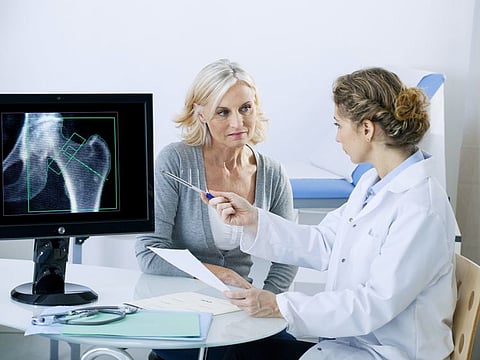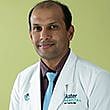Osteoporosis: Why women are more at risk
The condition affects mostly older women, but prevention starts when you are younger

When you hear the word osteoporosis, you may think of an old lady, feeble and hunched over a walker. But osteoporosis doesn’t only happen to older women. It affects women and men from all backgrounds. It can even happen when people are younger, if they have certain risk factors.
Women are more at risk of developing osteoporosis than men because the hormone changes that happen at menopause directly affect bone density. The female hormone oestrogen is essential for healthy bones and it decreases as menopause approaches. According to World Health Organisation figures, around 30 per cent of postmenopausal women suffer from osteoporosis, a condition where bones become weak and brittle, and may increase the risk of fractures.
Crucial role of oestrogen
“Bone problems tend to affect women more than men, primarily due to hormonal fluctuations experienced throughout life,” says Dr Ranjith Narayan, Orthopedics Specialist at Aster Hospital, Mankhool. “Women’s susceptibility to bone problems can be attributed to factors such as hormonal changes during menopause, lower peak bone mass compared to men, and longer lifespans.”
Dr Mujeeb Muhammad Shaik, Clinical Assistant Professor and Consultant, Orthopaedic Surgery, Thumbay University Hospital, says it was even worse for women in the past because social expectations prevented them from participating in weight-bearing exercises, which are crucial for bone health. “Additionally, a number of elements including poor diet, calcium loss during pregnancy and nursing, particular medical disorders, and drugs, can together contribute to the higher occurrence of bone problems in women,” says Dr Shaik. “While these characteristics make women more likely to experience bone issues, it’s crucial for both sexes to focus good nutrition, exercise, and preventative healthcare measures in order to maintain optimal bone health over the course of their lifetimes.”

Bones are made up of a matrix of proteins and minerals, making them both strong and flexible. They contain osteocytes, which are special cells that maintain this matrix. The hormone oestrogen regulates bone metabolism. It is essential to bone health because it promotes the activity of osteoblasts, which are the cells that make new bone.
“Oestrogen plays a vital role in regulating bone turnover, and its decline accelerates bone loss. This hormonal imbalance weakens bones, rendering them more prone to fractures,” explains Dr Arun Krishnan, Specialist in Orthopaedics at Aster Hospital, Al Qusais.
Difficult diagnosis
The diagnostic process for osteoporosis differs depending on a woman’s age. Diagnosing osteoporosis in women can be complicated, especially if they haven’t reached menopause. Typically, if a woman is younger than 50, a DEXA scan will not be immediately performed unless a preliminary exam and labs indicate that the risk of osteoporosis is high.
During the diagnostic process, a doctor will take a physical exam and medical history, which will help them determine if your risk of developing osteoporosis is high. If your symptoms and physical exams warrant further testing, it will be done. Other tests that measure levels of nutrients or hormones in the blood or check for abnormalities that could indicate a chronic disease will also be performed.

“Getting a bone density test commonly known as a DEXA scan depends on a number of unique characteristics,” says Dr Shaik. “In general, it is advised for women without certain risk factors to think about getting their bone density checked around the age of 65. For those at higher risk, such as those who go through early menopause, have a family history of osteoporosis, use certain medications that impair bone health, or have illnesses like rheumatoid arthritis or low body weight, earlier testing may be recommended.”
Additionally, women who have experienced fragility fractures or who have behaviours like smoking or binge drinking may need to be evaluated sooner. “The best way to decide the right time for bone density testing is to see a healthcare professional, since they can provide specific advice based on the particular health profile associated with each woman, allowing for prompt action as required,” advises Dr Shaik.
Prevention possible
The prevention of osteoporosis in women should start as early as possible. Young women and teens can implement certain lifestyle changes that can help them reduce their risk of developing osteoporosis and protect their bone health.
Taking charge of bone health requires a multifaceted approach, as Dr Krishnan outlines, adopting a healthy lifestyle is fundamental. “A balanced diet rich in calcium and vitamin D nourishes bones, while weight-bearing exercises such as walking and weightlifting strengthen bones and muscles,” he adds. “Abstaining from smoking and limiting alcohol consumption supports overall bone health,” he adds.

Experts also recommend consuming health supplements that compose of bone-building nutrients such as calcium, magnesium, and boron from marine algae called Lithothamnium Calcareum. Adequate calcium and vitamin D intake are important for maintaining strong bones. While calcium is a major component of bone tissue, vitamin D helps the body absorb the calcium from food. Women should aim to consume at least 1000-1300mg of calcium and 400-800 IU of vitamin D daily. One can include it in the form of supplements in their diet plan.
Medication and treatment
Medication and hormone therapy are essential components of the treatment of osteoporosis because they help to strengthen bones and lower the risk of fracture. Dr Shaik says Alendronate and zoledronic acid are examples of bisphosphonates that work by preventing cells from resorbing bone, hence preserving or boosting bone density. “To stop additional bone loss, selective oestrogen receptor modulators (SERMs), such as raloxifene, mimic the effects of oestrogen in the bones. A hormone called calcitonin, which controls calcium levels, is used to reduce bone loss and ease pain brought on by fractures.”
Hormone replacement therapy (HRT) is a medication that mimics the female hormones oestrogen and progesterone. It can be used to help manage symptoms of menopause and to strengthen bones. It can help to prevent osteoporosis in the years around menopause, especially if you have an early onset.
To offset the hormonal loss that occurs after menopause and help preserve bone mass, hormone replacement therapy (HRT) entails taking oestrogen and progestin. Together, these therapies help people with osteoporosis strengthen their bones, reduce the risk of fractures, and generally live better.
“Its use is judiciously reserved for postmenopausal women requiring it for other health concerns due to potential risks,” warns Dr Krsihnan.
For women grappling with osteoporotic fractures, advanced procedures offer relief. Dr Narayan says minimally invasive procedures such as vertebroplasty and kyphoplasty stabilise fractured vertebrae and alleviate pain. In vertebroplasty, bone cement is injected into the fractured vertebra, while kyphoplasty involves inflating a balloon to create space before cement injection.
“In severe cases of spinal instability, spinal fusion surgery joins vertebrae to enhance stability,” says Dr Narayan. “There are also emerging techniques that utilise specialised implants and imaging-guided procedures to reduce pain from spinal fractures, all while minimising invasiveness.”
Sign up for the Daily Briefing
Get the latest news and updates straight to your inbox



